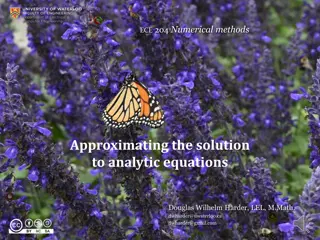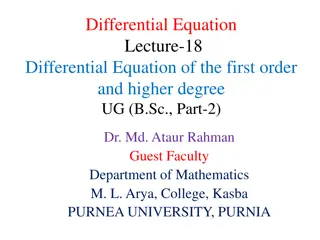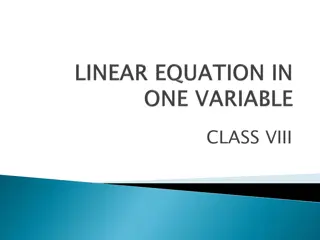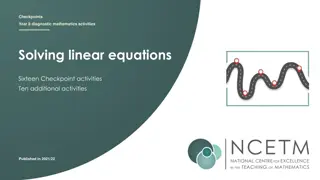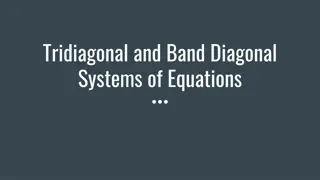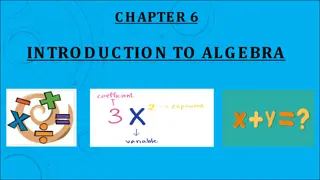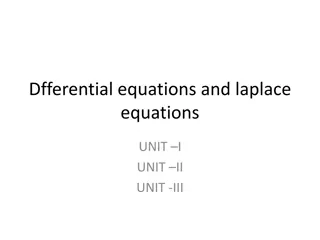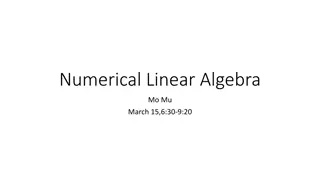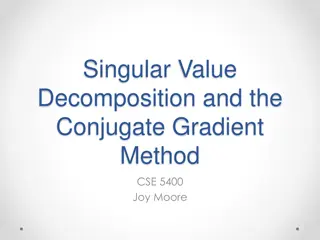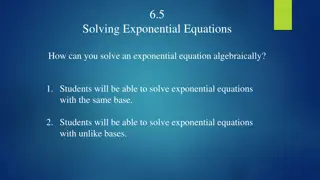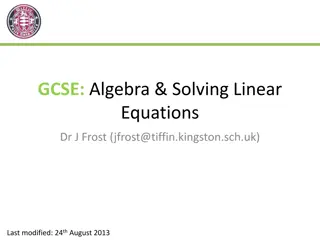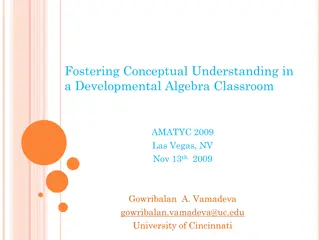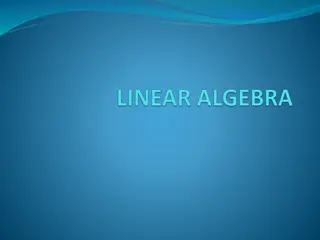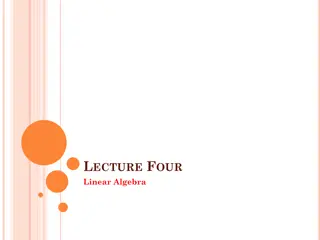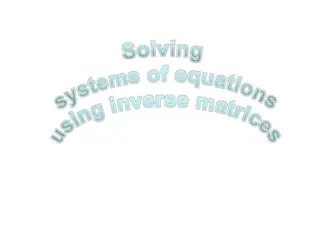Matrix Algebra for Solving Systems of Equations
Explore the application of matrix algebra in solving systems of equations through a practical example involving the interpolation of rocket velocity data. Learn how to set up equations in matrix form to find the coefficients profile of the velocity polynomial, illustrating the concept effectively.
Download Presentation

Please find below an Image/Link to download the presentation.
The content on the website is provided AS IS for your information and personal use only. It may not be sold, licensed, or shared on other websites without obtaining consent from the author.If you encounter any issues during the download, it is possible that the publisher has removed the file from their server.
You are allowed to download the files provided on this website for personal or commercial use, subject to the condition that they are used lawfully. All files are the property of their respective owners.
The content on the website is provided AS IS for your information and personal use only. It may not be sold, licensed, or shared on other websites without obtaining consent from the author.
E N D
Presentation Transcript
Autar Kaw Humberto Isaza http://nm.MathForCollege.com Transforming Numerical Methods Education for STEM Undergraduates
After reading this chapter, you should be able to: 1. setup simultaneous linear equations in matrix form and vice-versa, 2. understand the concept of the inverse of a matrix, 3. know the difference between a consistent and inconsistent system of linear equations, and 4. learn that a system of linear equations can have a unique solution, no solution or infinite solutions.
Matrix algebra is used for solving systems of equations. Can you illustrate this concept? Matrix algebra is used to solve a system of simultaneous linear equations. In fact, for many mathematical procedures such as the solution to a set of nonlinear equations, interpolation, integration, and differential equations, the solutions reduce to a set of simultaneous linear equations. Let us illustrate with an example for interpolation.
The upward velocity of a rocket is given at three different times on the following table. Table 5.1. Velocity vs. time data for a rocket Time, t Velocity, v (s) (m/s) 5 8 12 106.8 177.2 279.2 The velocity data is approximated by a polynomial as ( ) = at t v + + 2 , c 5 t 12. bt a , , b c Set up the equations in matrix form to find the coefficients profile. of the velocity
( ) ( , ) ( ) The polynomial is going through three data 5.1. , 5 1 = t where from table , , and , t , t v t v v 1 1 2 2 3 3 = 106 8 . v 1 = = , 8 177 2 . t v 2 2 = = 12 , 279 2 . t v 3 3 ( ) t = + + 2 Requiring that passes through the three data points gives v at bt c ( ) t 1 ( ) t 2 ( ) t 3 = = + + 2 1 v v at bt c 1 1 = = + + 2 2 v v at bt c 2 2 = = + + 2 3 v v at bt c 3 3
( ) ( , ) ( ) Substituting the data gives , , , and , t v t v t v 1 1 2 2 3 3 ( ) 52 ( ) 5 + + = 106 8 . a b c ( ) 82 ( ) 8 + + = 177 2 . a b c ( 122 ) ( ) 12 + + = 279 2 . a b c or + + = 25 5 106 8 . a b c + + = 64 8 177 2 . a b c + + = 144 12 279 2 . a b c
This set of equations can be rewritten in the matrix form as + + 25 5 106 8 . a b c + + = 64 8 177 2 . a b c + + 144 12 279 2 . a b c The above equation can be written as a linear combination as follows 25 5 1 106 8 . + + = 64 8 1 177 2 . a b c 144 12 1 279 2 . and further using matrix multiplication gives 25 5 1 106 8 . a = 64 8 1 177 2 . b 144 12 1 279 2 . c
The previous is an illustration of why matrix algebra is needed. The complete solution to the set of equations is given later in this chapter. A general set of linear equations and m n unknowns, + + + = a x a x a x c 11 1 12 2 1 1 n n + + + = a x a x a x c 21 1 22 2 2 2 n n . . + 2 1 1 + + = ........ a x a x a x c 2 m m mn n m
can be rewritten in the matrix form as . . a a a x c 11 12 1 1 1 n . . a a a x c 21 22 2 2 2 n = . . a a a x c 1 2 m m mn n m Denoting the matrices by , , and , the system of equation is A X C A X A C , where is called the coefficient matrix, is called the right hand side vector and is called the solution vector. X = C
X A Sometimes That is systems of equations are written in the augmented form. = C c a a ...... a 1 11 12 1 n c a a ...... a 2 21 22 2 n = A C a a ...... a c 1 2 m m mn n
A system of equations can be consistent or inconsistent. What does that mean? X A A system of equations is consistent if there is a solution, and it is inconsistent if there is no solution. However, a consistent system of equations does not mean a unique solution, that is, a consistent system of equations may have a unique solution or infinite solutions (Figure 1). = C [A][X]= [B] Consistent System Inconsistent System Unique Solution Infinite Solutions Figure 5.1. Consistent and inconsistent system of equations flow chart.
Give examples of consistent and inconsistent system of equations. Solution a) The system of equations 2 4 6 x = 1 3 4 y is a consistent system of equations as it has a unique solution, that is, 1 x = 1 y
b) The system of equations 2 4 6 x = 1 2 3 y is also a consistent system of equations but it has infinite solutions as given as follows. Expanding the above set of equations, + = 2 4 6 x y + = 2 3 x y
( ) y you can see that they are the same equation. Hence, any combination of satisfies, 6 4 2 = + y x that x, is a solution. For example is a solution. Other solutions include ( ) ( ) 1 , 1 , = y x , , and so on. ( ) ) 25 . 1 , 5 . 0 ( , = y x ( , y x ) = ) 5 . 1 , 0 ( c) The system of equations 2 4 6 x = 1 2 4 y is inconsistent as no solutions exists.
How can one distinguish between a consistent and inconsistent system of equations? X A C A A A system of equations the augmented matrix is consistent if the rank of is equal to the rank of = C . X A A A system of equations is inconsistent if the rank of is less than the rank of the augmented matrix . C A = C But, what do you mean by rank of a matrix? The rank of a matrix is defined as the order of the largest square submatrix whose determinant is not zero.
What is the rank of 3 1 2 A = ? 2 0 5 1 2 3 Solution The largest square submatrix possible is of order 3 and that is itself. Since the rank of , 0 23 ) det( = A . 3 ] [ = A [A ]
What is the rank of 3 1 2 A = 2 0 5 ? 1 5 7 Solution The largest square submatrix of the rank of is less than 3. The next largest square submatrix would be a 2 2 matrix. One of the square submatrices of is ] [A = is of order 3 and that is itself. Since , [A ] [A ] det( ) 0 A [A ] 3 1 B = 2 0 = And submatrices to establish that the rank of is 2. . Hence the rank of 0 is 2. There is no need to look at other 2 2 ] [A det( ) 2 B [A ]
How do I now use the concept of rank to find if 25 5 1 106 8 . x 1 = 64 8 1 177 2 . x 2 144 12 1 279 2 . x 3 is a consistent or inconsistent system of equations?
Solution The coefficient matrix is 25 5 1 A = 64 8 1 144 12 1 and the right hand side vector is
The augmented matrix is 25 5 1 106 8 . B = 64 8 1 177 2 . 144 12 1 279 2 . Since there are no square submatrices of order 4 as is a matrix, the rank of is at most 3. So let us look at the square submatrices of of order 3; if any of these square submatrices have determinant not equal to zero, then the rank is 3. For example, a submatrix of the augmented matrix is ] [B 3 4 [B ] [B ] [B ]
25 5 1 = [D ] 64 8 1 144 12 1 has. Hence the rank of the augmented matrix is 3. Since , the rank of is 3. Since the rank of the augmented matrix equals the rank of the coefficient matrix , the system of equations is consistent. = det( ) 84 0 D A = [B ] [ ] [ ] [A ] D [B ] [A ]
Use the concept of rank of matrix to find if 25 5 1 106 8 . x 1 = 64 8 1 177 2 . x 2 89 13 2 284 0 . x 3 Is consistent or inconsistent?
Solution The coefficient matrix is given by 25 5 1 A = 64 8 1 89 13 2 and the right hand side 106 8 . C = 177 2 . 284 0 .
Since there are no square submatrices of order 4 as is a 4 3 matrix, the rank of the augmented is at most 3. So let us look at square submatrices of the augmented matrix of order 3 and see if any of these have determinants not equal to zero. For example, a square submatrix of the augmented matrix is [B ] [B ] [B ] [B ] 25 5 1 D = 64 8 1 89 13 2 = Has the augmented matrix and find their determinants. ] [B . This means, we need to explore other square submatrices of order 3 of det( ) 0 D
That is, 5 1 106 8 . E = 8 1 177 2 . 13 2 284 0 . = det( ) 0 E 25 5 106 8 . F = 64 8 177 2 . 89 13 284 0 . = det( ) 0 F 25 1 106 8 . G = 64 1 177 2 . 89 2 284 0 . = det( ) 0 G
All the square submatrices of order determinant. So the rank of the augmented matrix is less than 3. Is the rank of augmented matrix equal to 2? One of the submatrices of the augmented matrix is ] [B of the augmented matrix have a zero ] [B 3 3 [B ] 2 [B ] 2 25 5 H = 64 8 And = 120 det( ) 0 H So the rank of the augmented matrix is 2. [B ]
Now we need to find the rank of the coefficient matrix [B ] 25 5 1 A = 64 8 1 89 13 2 and = det( ) 0 A [A ] So the rank of the coefficient matrix is less than 3. A square submatrix of the coefficient matrix is ] [A 5 1 J = 8 1 = det( ) 3 0 J So the rank of the coefficient matrix is 2. [A ]
Hence, the rank of the coefficient matrix equals the rank of the augmented matrix . So the system of equations is consistent. ] [B [A ] = [ [ ] A ] [ ] X C
Use the concept of rank to find if 25 5 1 106 8 . x 1 = 64 8 1 177 2 . x 2 89 13 2 280 0 . x 3 is consistent or inconsistent
The augmented matrix is 25 5 1 : 106 8 . B = 64 8 1 : 177 2 . 89 13 2 : 280 0 . Since there are no square submatrices of order 4 4 as the augmented matrix is a 4 3 matrix, the rank of the augmented matrix is at most 3. So let us look at square submatrices of the augmented matrix (B) of order 3 and see if any of the 3 3 submatrices have a determinant not equal to zero. For example, a square submatrix of order 3 3 of ] [B = 2 13 89 [B ] [B ] 25 5 1 D 64 8 1 det(D) = 0
So it means, we need to explore other square submatrices of the augmented matrix [B ] 5 1 106 8 . E = 8 1 177 2 . 13 2 280 0 . det( 0 12 0 . 0 E [B ] So the rank of the augmented matrix is 3. The rank of the coefficient matrix is 2 from the previous example. Since the rank of the coefficient matrix is less than the rank of the augmented matrix , the system of equations is inconsistent. Hence, no solution exists for ] [B ] [ ] [ ] [ C X A = [A ] [A ]
In a system of equations matrix is the same as the augmented matrix . If in addition, the rank of the coefficient matrix is same as the number of unknowns, then the solution is unique; if the rank of the coefficient matrix is less than the number of unknowns, then infinite solutions exist. that is consistent, the rank of the coefficient ] [ C A = [ [ ] A ] [ ] X C [A ] [A ] [A ]
[A] [X] = [B] Consistent System if rank (A) = rank (A.B) Inconsistent System if rank (A) < rank (A.B) Unique solution if rank (A) = number of unknowns Infinite solutions if rank (A) < number of unknowns Figure 5.2. Flow chart of conditions for consistent and inconsistent system of equations.
We found that the following system of equations 25 5 1 106 8 . x 1 = 64 8 1 177 2 . x 2 144 12 1 279 2 . x 3 is a consistent system of equations. Does the system of equations have a unique solution or does it have infinite solutions?
Solution The coefficient matrix is 25 5 1 A = 64 8 1 144 12 1 and the right hand side is 106 8 . C = 177 2 . 279 2 . While finding out whether the above equations were consistent in an earlier example, we found that the rank of the coefficient matrix (A) equals rank of augmented matrix equals 3. The solution is unique as the number of unknowns = 3 = rank of (A). A C
We found that the following system of equations 25 5 1 106 8 . x 1 = 64 8 1 177 2 . x 2 89 13 2 284 0 . x 3 is a consistent system of equations. Is the solution unique or does it have infinite solutions.
Solution While finding out whether the above equations were consistent, we found that the rank of the coefficient matrix equals the rank of augmented matrix Since the rank of < number of unknowns = 3, infinite solutions exist. 2 ] [ = A ( ) equals 2 [A ] A C If we have more equations than unknowns in [A] [X] = [C], does it mean the system is inconsistent? No, it depends on the rank of the augmented matrix and the rank of [A ] A C
a) For example 25 5 1 106 8 . x 1 64 8 1 177 2 . = x 2 144 12 1 279 2 . x 3 89 13 2 284 0 . is consistent, since rank of augmented matrix = 3 rank of coefficient matrix = 3 Now since the rank of (A) = 3 = number of unknowns, the solution is not only consistent but also unique.
b) For example 25 5 1 106 8 . x 1 64 8 1 177 2 . = x 2 144 12 1 279 2 . x 3 89 13 2 280 0 . is inconsistent, since rank of augmented matrix = 4 rank of coefficient matrix = 3
c) For example 25 5 1 106 8 . x 1 64 8 1 177 2 . = x 2 50 10 2 213 6 . x 3 89 13 2 280 0 . is consistent, since rank of augmented matrix = 2 rank of coefficient matrix = 2 But since the rank of (A) = 2 < the number of unknowns = 3, infinite solutions exist.
Consistent systems of equations can only have a unique solution or infinite solutions. Can a system of equations have more than one but not infinite number of solutions? No, you can only have either a unique solution or infinite solutions. Let us suppose has two solutions ] [ ] [ ] [ C X A = and so that ] [Z [Y ] = [ [ ] ] [ ] A Y C = [ [ ] ] [ ] A Z C
If r is a constant, then from the two equations Y A r = C r ) ( Z A ) C ( = 1 1 r r Adding the above two equations gives ( Y A ) A ( C ) C + = + 1 1 r r Z r r ( ( Y r A ) Z ) = + 1 r C
Hence ( Y ) Z + 1 r r is a solution to A = X C Since r is any scalar, there are infinite solutions for of the form = [ [ ] A ] [ ] X C ( Y ) Z + 1 r r
B C A = ] [ If [ ] [ A is defined, it might seem intuitive that , = ] [ ] B C but matrix division is not defined like that. However an inverse of a matrix can be defined for certain types of square matrices. The inverse of a square matrix , if existing, is denoted by such that ] [ A [A ] 1 = = 1 1 [ [ ] A ] [ ] [ ] [ ] A I A A Where is the identity matrix. ] [I
In other words, let [A] be a square matrix. If [B] is another square matrix of the same size such that , then [B] is the inverse of [A]. [A] is then called to be invertible or nonsingular. If does not exist, is called noninvertible or singular. If [A] and [B] are two matrices such that , then these statements are also true = [ [ ] B ] [ ] A I [A [ ] [ ] B 1 [ ] A n n = ] [ ] A I [B] is the inverse of [A] [A] is the inverse of [B] [A] and [B] are both invertible [A] [B]=[I]. [A] and [B] are both nonsingular all columns of [A] and [B]are linearly independent all rows of [A] and [B] are linearly independent.
Determine if 3 2 = [B ] 5 3 is the inverse of 3 2 = [A] 5 3
Solution 3 2 3 2 = [ ][ ] B A 5 3 5 3 1 0 = 0 1 = [I ] Since, = [ [ ] B ] [ ] A I [B] is the inverse of [A] and [A] is the inverse of [B].
Can I use the concept of the inverse of a matrix to find the solution of a set of equations [A] [X] = [C]? Yes, if the number of equations is the same as the number of unknowns, the coefficient matrix is a square matrix. Given ] [ ] [ ] [ C X A = [A ] 1 1 Then, if exists, multiplying both sides by . ] [ A = [ ] A 1 1 [ ] [ ][ ] [ ] [ ] A A X A C = 1C [ [ ] I ] [ ] [ ] X A = 1C [ ] [ ] [ ] X A 1 [ ] A = This implies that if we are able to find , the solution vector of is simply a multiplication of and the right hand side vector, [ [ ] A ] [ ] X C 1 [ ] A [C ]
n n n n 1 [ ] A n If is a inverse of a matrix [ matrix, then is a matrix and according to the definition of n n n [A ] = 1 [ ] A ] [ ] A I Denoting a a a 11 12 1 n a a a 21 22 2 n = [ ] A a a a 1 2 n n nn
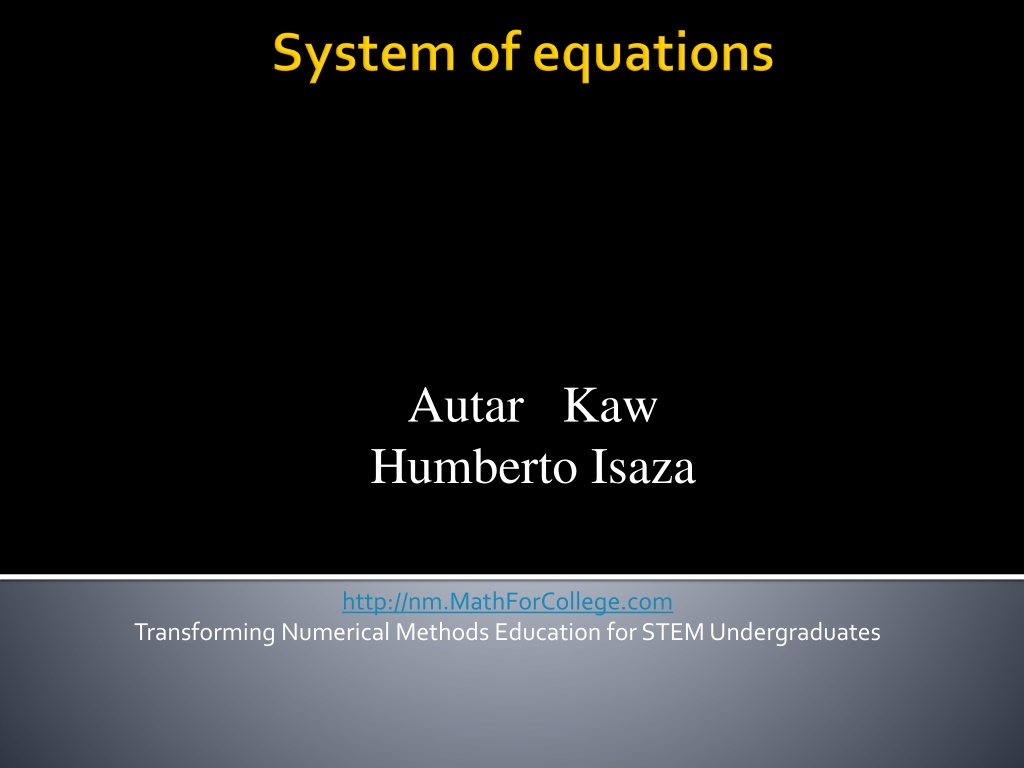
 undefined
undefined


 undefined
undefined

